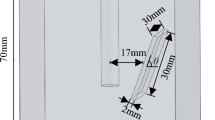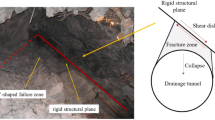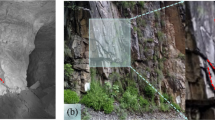Abstract
In the past, the selection of the number of empty holes between blast holes heavily relied on the subjective experience of practitioners, leading to unsatisfactory blasting results. The number of empty holes between blast holes is particularly important for the perforation of explosive cracks. In order to determine the optimum number of empty holes for inducing the propagation of explosive cracks, a two-dimensional numerical model of two-hole blasting was established based on the continuous-discontinuous element method (CDEM) using polymethyl methacrylate (PMMA) as the medium, and numerical simulation of various working conditions was conducted; the simulation results are basically consistent with the PMMA model test. Through the analysis of blasting parameters, the optimal number of empty holes with a certain hole spacing is fitted. The following conclusions are drawn: (1) There is a threshold for variable x. When x exceeds 50, the presence of empty holes cannot lead to the perforation of explosive cracks between the blast holes. (2) When x is below 50, the optimal number of empty holes inducing the propagation of explosive cracks can be determined through fitting an empirical formula. By adjusting the number of empty holes between blast holes, a significant spacing between adjacent blast holes was achieved, allowing for effective penetration, so as to effectively “induce” the direction of the fracture zone and make full use of the energy of explosives. The research results of this paper are conducive to the research of directional blasting technology and provide certain references for the optimization of precision blasting parameters.









Similar content being viewed by others
References
Fourney WL, Holloway DC, Dally JW (1975) Fracture initiation and propagation from a center of dilatation. Int J Fract 11:1011–1029. https://doi.org/10.1007/BF00033847
Singh PK, Roy MP, Paswan, Ranjit K (2014) Controlled blasting for long term stability of pit-walls. Int J Rock Mech Min Sci 70:388–399. https://doi.org/10.1016/j.ijrmms.2014.05.006
Fourney WL (1993) Mechanisms of rock fragmentation by blasting. Excavation, Support and Monitoring. 39–69. https://doi.org/10.1016/B978-0-08-042067-7.50009-X
Hino K (1956) Fragmentation of rock through blasting and shock wave theory of Blasting. In: Paper presented at the The 1st U.S. Symposium on Rock Mechanics (USRMS). USRMS Golden, Colorado
Latham JP, Munjiaza A, Lu P (1999) Rock fragmentation by blasting—a literature study of research in the 1980’s and 1990’s. Fragblast 3:193–212. https://doi.org/10.1080/13855149909408046
Clark LD, Jones RJ, Howell RC (1971) Blasting mechanics. Trans Am Instit Min Eng. https://doi.org/10.1007/978-94-011-6501-3_17
Zhao JJ, Zhang Y, Ranjith PG (2017) Numerical simulation of blasting-induced fracture expansion in coal masses. Int J Rock Mech Min Sci 100:28–39. https://doi.org/10.1016/j.ijrmms.2017.10.015
Hu SB, Wang EY, Kong XG (2015) Damage and deformation control equation for gas-bearing coal and its numerical calculation method. J Nat Gas Sci Eng 25:166–179. https://doi.org/10.1016/j.jngse.2015.04.039
Guo DY, Zhao JC, Zhu TG, Zhang C (2020) Crack propagation and coalescence mechanism of double-hole cumulative blasting in coal seam. Chin J Eng 42:1613. https://doi.org/10.13374/j.issn2095-9389.2020.05.19.001
Yang RS, Wang YB, Yue ZW, Liu GQ (2013) Dynamic behaviors of crack propagation in directional fracture blasting with two holes. Explos Shock Waves 33:631–637
Yang RS, Wang YB, Yang LY (2012) Dynamic caustics experimental study of crack propagation in two borehole cut blasting. J China Univ Min Technol 41:865–872
Nakamura Y, Cho SH, Yoneoka M, Yamamoto M, Kaneko K (2004) Model experiments on crack propagation between two charge holes in blasting. Sci Technol Energ Mater 65:34–39. https://api.semanticscholar.org/CorpusID:137511495
Cho SH, Nakamura Y, Mohanty B, Yang HS, Kaneko K (2008) Numerical study of fracture plane control in laboratory-scale blasting. Eng Fract Mech 75:3966–3984. https://doi.org/10.1016/J.ENGFRACMECH.2008.02.007
Yang RS, Wang YB, Guo DM, Xue HJ (2016) Experimental research of crack propagation in polymethyl methacrylate material containing flaws under explosive stress waves. J Test Eval 44:20140055. https://doi.org/10.1520/JTE20140055
Dally JW (1980) An introduction to dynamic photoelasticity. Exp Mech 20:409–416. https://doi.org/10.1007/BF02320881
Li SH, Wang JG, Liu BS, Dong D (2007) Analysis of critical excavation depth for a jointed rock slope using a face-to-face discrete element method. Rock Mech Rock Eng 40:331–348. https://doi.org/10.1007/s00603-006-0084-9
Wang YN, Zhao MH, Li SH, Wang JG (2015) Stochastic structural model of rock and soil aggregates by continuum-based discrete element method. Sci China: Techn Sci z1:12. https://doi.org/10.1360/04zze13
Feng C, Liu XM, Lin QD, Li SH (2022) A simple particle-spring method for capturing the continuous-discontinuous processes of brittle materials. Eng Anal Boundary Elem 139:221–231. https://doi.org/10.1016/j.enganabound.2022.03.015
Li SH, Zhao MH, Wang YN, Rao Y (2004) A new numerical method for dem - block and particle model. Int J Rock Mech Min Sci 41:414–418. https://doi.org/10.1016/j.ijrmms.2004.03.076
Li SH, Zhao MH, Wang YN, Rao Y (2021) A novel three-dimensional hydraulic fracturing model based on continuum-discontinuum element method. Comput Methods Appl Mech Eng 383:113–887. https://doi.org/10.1016/j.ijrmms.2004.03.076
Feng PX, Li YP, Wang XY, Feng C, Zhang YM (2022) Numerical analysis on two-layer bundle-hole cut blasting with continuous-discontinuous elements. Geotech Geol Eng 40:5045–5054. https://doi.org/10.1007/s10706-022-02198-3
Wang HZ, Yu AF, Feng C, Ling XD, Chen GX, Gu M, Zhu XQ (2022) An Efficient CDEM-based method to calculate full time-space natural fragment field of shell-bearing explosives. Int J Impact Eng. https://doi.org/10.1016/j.ijimpeng.2021.104099
Wang HZ, Yu AF, Feng C, Ling XD, Chen GX, Gu M, Zhu XQ (2019) An efficient CDEM-based method to calculate full-scale fragment field of warhead. Int J Impact Eng 133:103331. https://doi.org/10.1016/j.ijimpeng.2019.103331
Ding CX, Yang RS, Zheng CD, Yang LY, He SL, Feng C (2021) Numerical analysis of deep hole multi-stage cut blasting of vertical shaft using a continuum-based discrete element method. Int J Impact Eng 14:1086. https://doi.org/10.1007/s12517-021-07425-4
Ding CX, Yang RS, Zheng CD, Yang LY, He SL, Feng C (2021) Hydraulic fracturing characteristics of water resisting rock mass with layered joints based on CDEM. Hazard Control Tunn Undergr Eng 3:9. https://doi.org/10.19952/j.cnki.2096-5052.2021.03.08
Zheng BX, Feng C, Song JQ, Guo RK, Li SH (2015) Numerical simulation study on the influence of explosive consumption on the fragmentation of hematite blasting. Blasting 32:8. https://doi.org/10.3963/j.issn.1001-478X.2015.03.011
Ding CX, Yang RS, Yang LY (2021) Experimental results of blast-induced cracking fractal characteristics and propagation behavior in deep rock mass. Int J Rock Mech Min Sci 142:104772. https://doi.org/10.1016/j.ijrmms.2021.104772
Ding CX, Yang RS, Lei Z, Wang M, Zhao Y, Lin H (2021) Fractal damage and crack propagation in decoupled charge blasting. Soil Dyn Earthq Eng 141:106503. https://doi.org/10.1016/j.soildyn.2020.106503
Yang RS, Ding CX, Yang LY (2016) Experimental study on interaction effect of dynamic cracks induced by blast. Blasting 33:2
Funding
The authors received financial support from the National Natural Science Foundation of China (NSFC) (52178324).
Author information
Authors and Affiliations
Corresponding author
Ethics declarations
Conflict of Interest
The authors declare no competing interests.
Additional information
Publisher's Note
Springer Nature remains neutral with regard to jurisdictional claims in published maps and institutional affiliations.
Rights and permissions
Springer Nature or its licensor (e.g. a society or other partner) holds exclusive rights to this article under a publishing agreement with the author(s) or other rightsholder(s); author self-archiving of the accepted manuscript version of this article is solely governed by the terms of such publishing agreement and applicable law.
About this article
Cite this article
Cao, R., Li, Y., Feng, C. et al. Study on the Guiding Mechanism of Multiple and Empty Holes Under Explosion Load. Mining, Metallurgy & Exploration 41, 277–286 (2024). https://doi.org/10.1007/s42461-023-00902-2
Received:
Accepted:
Published:
Issue Date:
DOI: https://doi.org/10.1007/s42461-023-00902-2




